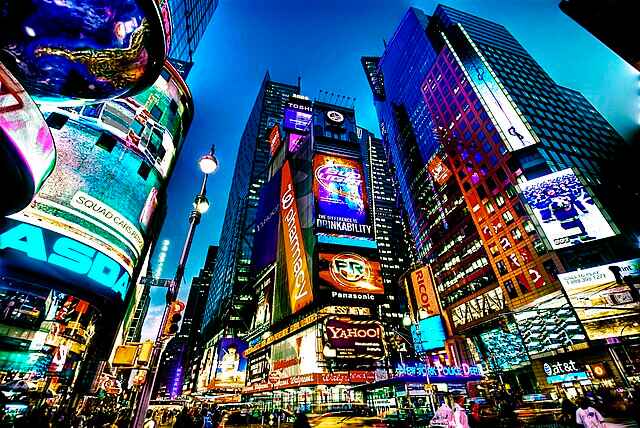Times Square has long been a symbol of New York City’s energy, shaped by its dazzling billboards and the constant flow of tourists, performers and everyday commuters. While it’s already a hotspot for entertainment, business and dining, some people argue that its next chapter could be even more exciting. Looking ahead, there are a few possible features that might transform Times Square by 2030 if developers, local government officials and the public decide to push for more changes. Below are five suggestions that don’t currently exist in Times Square but could soon become a reality.
A Landmark Casino
One of the most talked-about ideas for Times Square’s near future is a casino. Although there isn’t currently one in the area, there have been proposals to build a world-class gaming establishment at the heart of Midtown. In late 2022, Caesars Entertainment and SL Green Realty announced that they were exploring the possibility of developing a casino resort in Times Square, complete with the Caesars Palace name. Music mogul Jay-Z even pledged over $250 million in grant money to move this plan forward. Supporters, including the Coalition for a Better Times Square, believe that a casino could boost the city’s economy and add a fresh layer of nightlife to a neighbourhood that already thrives on theatre and tourism.
It’s not all excitement, though. Many local residents and organisations worry about the effect a casino might have on Times Square’s character. Concerns include potential rises in crime and traffic, along with fears that Broadway theatre could lose its unique identity. The United Federation of Teachers also opposes the scheme, suggesting it could undermine the Theatre District and water down the distinctive charm of Broadway shows. There’s also the fact that online casinos are now more popular than offline casinos, and you can’t compare casinos before parting with money like you can on the internet if Times Square only has one of them. Still, the casino debate shows no signs of disappearing, and if the project gets the green light, Times Square could look and feel very different by 2030.
High-Tech Outdoor Performances
Times Square already hosts a variety of performances, from musicians busking in the streets to flashy events around New Year’s Eve. However, it’s possible that by 2030, we could see an even more high-tech approach to outdoor entertainment. Imagine free shows using holographic displays or augmented reality, projected onto the square’s towering screens. Visitors could point their phones at the screens to unlock extra layers of the performance, such as backstage interviews or alternate camera angles. Bands might hold mini-concerts where the stage is partly virtual, blending real performers with digital effects to produce something new and attention-grabbing.
This kind of technology is already being tested in other parts of the world – with a lot of success in instances like ABBA’s holographic world tour – so it wouldn’t be surprising if Times Square embraced it too. Interactive art could also be a part of the mix, letting passers-by play with large-scale digital murals or signboards that respond to movement or sound. By 2030, the place might be buzzing with innovative spectacles that break the traditional boundaries of theatre and street performance.
Rooftop Green Walkways
Green spaces in Times Square can be hard to come by, with so much of the area taken up by tall buildings, busy roads and constant foot traffic. In the future, developers might look upwards for new ways to bring greenery into the district. One idea could be the creation of rooftop green walkways that connect neighbouring buildings. These elevated paths would be lined with planters, shrubs and small trees, providing pedestrians with a refreshing escape from street-level bustle.
Picture strolling along a walkway filled with potted plants, benches and local artwork, taking in views of the bright signs below. Such a feature would add a dose of calm in a part of Manhattan that’s known for its never-ending activity. It might also benefit the environment by improving air quality and helping to insulate buildings, potentially saving energy. Rooftop gardens have popped up elsewhere in the city, but a large-scale network in Times Square would be a show-stopper for both tourists and locals.
A Multi-Level Food Hall
Times Square is packed with restaurants, fast-food chains, and snack stands, yet it can still be difficult to find a truly diverse mix of dining options in one location. A multi-level food hall could solve this, bringing an array of local and international cuisines under one roof. This isn’t just about a single row of stalls but rather a full-scale culinary experience spread across several storeys.
A first floor could host quick bites and dessert corners, while a second floor might feature family-friendly eateries. Another level could offer more upscale dining, with rooftop seating for those who love a view. Live cooking demos, food festivals and pop-ups could occupy a dedicated space on one of the floors, allowing up-and-coming chefs to experiment and showcase their talents. Alongside the standard pizza, burgers and street foods, there might be rotating stalls celebrating dishes from around the world, ensuring variety for both everyday diners and foodies on the lookout for something new.
Self-Cleaning Streets and Public Spaces
Nobody would describe Times Square as pristine. Its popularity means it’s full of litter, especially during peak tourist seasons. By 2030, innovative sanitation methods could be introduced, making the streets effectively self-cleaning. Special surfaces might be installed that break down rubbish or stains with the help of sunlight or mild chemical treatment. Robots or automated cleaning machines could roll through at set times, gathering bigger pieces of waste and scrubbing away spills before they become an eyesore.
Such technology has been tested in other cities, particularly in areas that see heavy foot traffic. Both Japan and South Korea already have self-cleaning streets. If Times Square were to adopt these systems, it would not only improve public health but also free up sanitation workers to tackle more difficult cleaning tasks. A less cluttered street could make a huge difference to how locals and visitors perceive the area, making it safer, more pleasant, and more in line with an environmentally friendly ethos.
These ideas might seem a bit far-fetched to some, but Times Square is no stranger to reinvention. From the transformation of its neon signs over the decades to the pedestrianising of certain areas, the neighbourhood constantly adapts. A casino resort, more sophisticated outdoor shows, rooftop gardens, a multi-level food hub and self-cleaning infrastructure could be the next wave of changes. Whether or not they all come to pass, one thing is almost certain: Times Square won’t stop evolving anytime soon. By 2030, it could be a very different place, and people from all walks of life might be drawn to its new attractions as much as the old, familiar favourites.





Be First to Comment